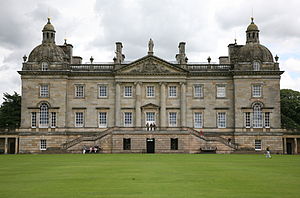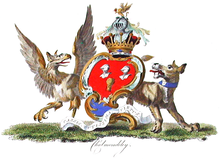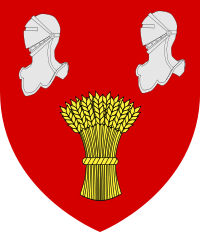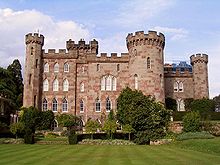- Marquess of Cholmondeley
-
 Houghton Hall, the ancestral home of the Marquess of Cholmondeley since the establishment of the title.
Houghton Hall, the ancestral home of the Marquess of Cholmondeley since the establishment of the title.
Marquess of Cholmondeley (
 /ˈtʃʌmli/ chumly) is a title in the Peerage of the United Kingdom. It was created in 1815 for George Cholmondeley, 4th Earl of Cholmondeley. Each Marquess of Cholmondeley is a descendant of Sir Robert Walpole, the first Prime Minister of Great Britain.
/ˈtʃʌmli/ chumly) is a title in the Peerage of the United Kingdom. It was created in 1815 for George Cholmondeley, 4th Earl of Cholmondeley. Each Marquess of Cholmondeley is a descendant of Sir Robert Walpole, the first Prime Minister of Great Britain.Contents
History
The Cholmondeley family descends from Sir Hugh Cholmondeley. His eldest son was Robert Cholmondeley, 1st Earl of Leinster, while his youngest son Thomas was the ancestor of the Barons Delamere. Another son, his namesake Hugh, was the father of Robert Cholmondeley. He succeeded to the estates of his uncle Lord Leinster and was created Viscount Cholmondeley, of Kells in the County of Meath, in the Peerage of Ireland in 1661. He was succeeded by his eldest son, the second Viscount. He was a supporter of King William III and Queen Mary II and also served as Comptroller of the Household and as Treasurer of the Household. In 1689 he was created Baron Cholmondeley, of Nantwich in the County of Chester, in the Peerage of England, with remainder to his younger brother George Cholmondeley. In 1706 he was further honoured when he was made Viscount Malpas, in the County of Chester, and Earl of Cholmondeley, in the County of Chester, also in the Peerage of England and with the same special remainders.
Lord Cholmondeley never married and was succeeded according to the special remainders (and according to the normal descent in the viscountcy of Cholmondeley) by his younger brother George, the second Earl. He was a prominent military commander and commanded the Horse Guards at the Battle of the Boyne in 1690. In 1715, ten years before he succeeded his elder brother, he was raised to the Peerage of Ireland in his own right as Baron Newborough, of Newborough in the County of Wexford, and in 1716 he was made Baron Newburgh, in the Isle of Anglesey, in the Peerage of Great Britain. On his death the titles passed to his son, the third Earl. He was a politician and held office as Lord Privy Seal and Chancellor of the Duchy of Lancaster.
He was succeeded by his grandson, the fourth Earl. He was the son of George Cholmondeley, Viscount Malpas. Lord Cholmondeley was also a prominent politician and served as Captain of the Yeomen of the Guard and as Lord Steward of the Household. In 1815 he was created Earl of Rocksavage, in the County of Chester, and Marquess of Cholmondeley, in the Peerage of the United Kingdom. He was succeeded by his eldest son, the second Marquess. He represented Castle Rising in the House of Commons but in 1821 he was summoned to the House of Lords through a writ of acceleration in his father's junior title of Baron Newburgh. Lord Cholmondeley was childless and was succeeded by his younger brother, the third Marquess. He sat as Member of Parliament for Castle Rising and South Hampshire. As of 2010[update] the titles are held by his great-great-great-grandson, the seventh Marquess, who succeeded his father in 1990.
A part of the office of Lord Great Chamberlain came into the Cholmondeley family through the marriage of the first Marquess of Cholmondeley to Lady Georgiana Charlotte Bertie, daughter of Peregrine Bertie, 3rd Duke of Ancaster and Kesteven.[1] The second, fourth, fifth, sixth and seventh holders of the marquessate have all held this office. As Lord Great Chamberlain, the present Marquess is, along with the Duke of Norfolk (the Earl Marshal), one of only two hereditary peers to retain automatic seats in the House of Lords after the passage of the House of Lords Act 1999.
Peers in the House of Lords can hold their 70th birthday parties in the Cholmondeley Room at the Palace of Westminster.[2] Among other uses, Baroness Elliot of Harwood organized a dinner in 1984 for all female Conservative members of Parliament and peers; and this event was held in this venue.[3] The Cholmondeley Room and Terrace and the Attlee Room are available for private functions, sponsored by Members for personal use or for external organisations.[4]
The courtesy title of the Marquess's heir is Earl of Rocksavage, while Lord Rocksavage's eldest son is known as Viscount Malpas.[5]
The family seats are Houghton Hall, Norfolk, and Cholmondeley Castle, which is surrounded by a 7,500 acres (30 km2) estate near Malpas, Cheshire.[6]
The family surname and the title of four of the peerages, Cholmondeley, is pronounced "Chumly".
Viscounts Cholmondeley (1661)
- Robert Cholmondeley, 1st Viscount Cholmondeley (d. 1681)
- Hugh Cholmondeley, 2nd Viscount Cholmondeley (1662–1725) (created Earl of Cholmondeley in 1706)
Earls of Cholmondeley (1706)
 The coat of arms of the Marquesses of Cholmondeley (circa 1764)
The coat of arms of the Marquesses of Cholmondeley (circa 1764)
- Hugh Cholmondeley, 1st Earl of Cholmondeley (1662–1725)[7]
- George Cholmondeley, 2nd Earl of Cholmondeley (1666–1733)
- George Cholmondeley, 3rd Earl of Cholmondeley (1703–1770)
- George Cholmondeley, Viscount Malpas (1724–1764)
- George James Cholmondeley, 4th Earl of Cholmondeley (1749–1827) (created Marquess of Cholmondeley in 1815)
Marquesses of Cholmondeley (1815)
- George James Cholmondeley, 1st Marquess of Cholmondeley (1749–1827)
- George Horatio Cholmondeley, 2nd Marquess of Cholmondeley (1792–1870)
- William Henry Hugh Cholmondeley, 3rd Marquess of Cholmondeley (1800–1884)
- George Henry Hugh Cholmondeley, 4th Marquess of Cholmondeley (1858–1923)[5]
- George Horatio Charles Cholmondeley, 5th Marquess of Cholmondeley (1883–1968)
- George Hugh Cholmondeley, 6th Marquess of Cholmondeley (1919–1990)
- David George Philip Cholmondeley, 7th Marquess of Cholmondeley (b. 1960)
The heir apparent is the present holder's eldest twin son Alexander Cholmondeley, Earl of Rocksavage (b. 2009).
See also
Notes
- ^ Portcullis: Deed of Covenant and Agreement between Lord Willoughby de Eresby, The Dowager Marchioness of Cholmondeley and the Marquis of Cholmondeley re the exercise of the Office of Hereditary Great Chamberlain (16 May 1829).
- ^ Thomson, Alice. "The House of Lords: the perks, the pay, the pomp," The Times (London). January 27, 2009.
- ^ House of Lords: dinner organized by Baroness Elliot of Harwood, 1984
- ^ House of Lords: Refreshment Department
- ^ a b As both sons had died before him, the 3rd marquess was succeeded in his titles by his grandson, who was eldest living son of the 3rd marquess' first-born heir presumptive -- see Peerage: 4th Marquess of Cholmondeley, ID #24219
- ^ Caroline, Donald. "The new garden at Houghton Hall, King’s Lynn, Norfolk," The Times (UK). May 11, 2008.
- ^ Cheshire County Council: Cholmondeley family, 1st Earl, records.
References
- Debrett, John, Charles Kidd, David Williamson. (1990). Debrett's Peerage and Baronetage. New York: Macmillan. 10-ISBN 0-333-38847-X; 13-ISBN 978-0-333-38847-1
- Lodge, Edmund. (1877). The Peerage and Baronetage of the British Empire as at Present Existing. London: Hurst and Blackett. OCLC 17221260
External links

Earls of Cholmondeley Hugh, 1st Earl (1706-1725) • George, 2nd Earl (1725-1733) • George, 3rd Earl (1733-1770) • George, 4th Earl (1770-1815)Marquesses of Cholmondeley George, 1st Marquess (1815-1827) • George, 2nd Marquess (1827-1870) • William, 3rd Marquess (1870-1884) • George, 4th Marquess (1884-1923) • George, 5th Marquess (1923-1968) • Hugh, 6th Marquess (1968-1990) • David, 7th Marquess (1990-)Categories:- 1815 establishments in the United Kingdom
- Marquessates
Wikimedia Foundation. 2010.


